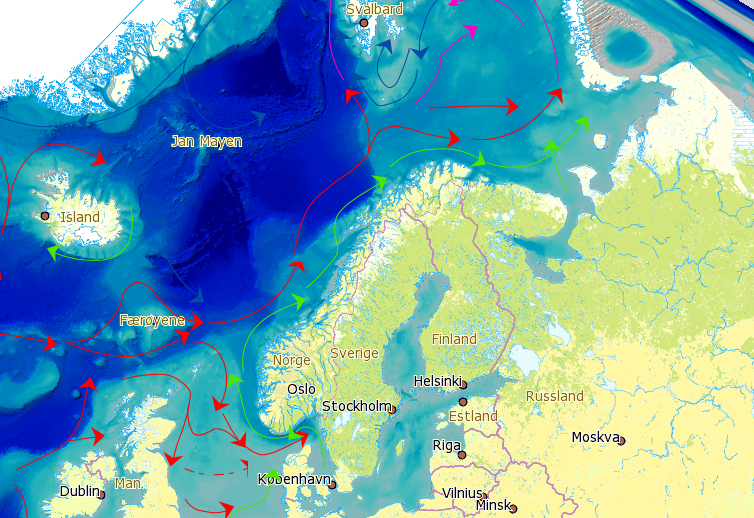The high productivity of our northern waters is related to the transport of warm waters across the North Atlantic. When warm Atlantic water from the south meets cold water from the Arctic Ocean in the Barents Sea, a divide occurs, called the polar front. The polar front affect ice formation and gives rise to important life functions.
Ocean currents in the North Atlantic
The Gulf Stream is the dominant ocean current in the North Atlantic (indicated by the red arrows). It has its origins at the American continent and contains warm and salty water. The Gulf Stream transports large amounts of heat to the northern parts of Europe.
Heat transfer is greatest in the winter because the flow velocity is highest at this time of year. The Gulf Stream has an almost constant temperature (15-20 °C) and salinity throughout the year. It gradually mixes with colder and less saline water from the north.
When the Gulf Stream approaches the Barents Sea, the temperature drops to around 5 °C in winter and 10 °C in summer. Salinity changes little and is around 36-35 (units of salinity)
The current goes through the Fram Strait west of Svalbard and into the Barents Sea (indicated by pink arrows). Here the waters meet colder and less saline southwestern Arctic ocean currents, shown with blue arrows. The Arctic currents may have a temperature of -2 to 2 °C and a salinity of less than 34
The Arctic currents result in a significantly colder climate on Greenland and along the Canadian coast past Labrador and Newfoundland than is the case for Europe's coastal areas.
Near the coast, on both the east and west sides of the North Atlantic, smaller coastal currents arise with a salinity of between 25 and 34 (indicated by green arrows). For these currents, temperature and salinity vary significantly according to the seasons. They are warmer than the Gulf Stream in summer and colder in winter. Salinity will be affected by the supply of fresh water from land.
Currents in the northern areas
Transport of Atlantic water varies over time. This is fundamental to the understanding of climate change and transport of eggs, larvae and zooplankton in the Barents Sea.
The map also indicates the polar front. The polar front divides the Barents Sea in two.
- In the southern part, relatively warm Atlantic waters and sub-Arctic ecosystems dominate
- In the northern part, cold Arctic waters and the Arctic ecosystem dominate.
The polar front greatly affects the ice cover in the Barents Sea and gives rise to important life functions. Transport of Atlantic water into the Barents Sea is an indicator in the management plan for the Barents Sea including Lofoten.
